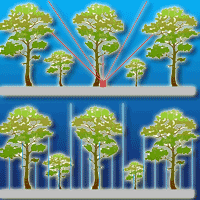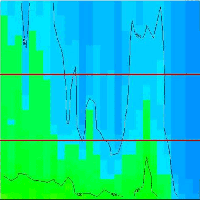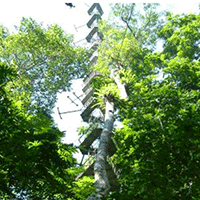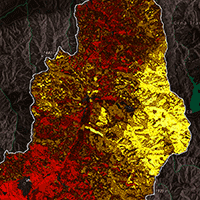
Bird composition and diversity in oak stands under variable coppice management in Northwestern Turkey
Vedat Beskardes (1) , Akif Keten (2), Meric Kumbasli (3), Burak Pekin (4), Ersel Yilmaz (5), Ender Makineci (6), Emrah Ozdemir (5), Hayati Zengin (7)
iForest - Biogeosciences and Forestry, Volume 11, Issue 1, Pages 58-63 (2018)
doi: https://doi.org/10.3832/ifor2489-010
Published: Jan 25, 2018 - Copyright © 2018 SISEF
Research Articles
Abstract
Coppice management results in profound differences in forest structure and composition, which in turn can modify habitat value for bird species. We measured bird species richness and composition at 50 sample plots in pure oak forest stands in northwestern Turkey, which differed in age, cover and height in association with coppice management. We recorded a total of 38 bird species and 699 individuals across all stands. Regression-based multimodel inference showed that structural features of forest stands strongly affect bird diversity and abundance. While canopy cover and tree height affect bird diversity positively, elevation of sampling plots, tree density and tree diameter at breast height (DBH) had a negative effect. In addition, constrained ordination analyses revealed that canopy cover was the most important factor influencing bird species composition. Forest stands that have 42-85% canopy cover, i.e., a few (2009-2580 oak trees) large tall (13.36-15.78 m) trees, were the most preferred habitat by bird species. However, we also found that different bird species favor different stand structural features. Thus, variation in stand structure from maintaining some coppice management across the landscape may be beneficial for rare or endangered species and result in greater landscape level biodiversity.
Keywords
Avian Fauna, Canopy Height, Vegetation Seral Stage, Canopy Cover, Multi-model Inference, Thrace
Authors’ Info
Authors’ address
Istanbul University, Faculty of Forestry, Forest Entomology and Protection Department, Istanbul (Turkey)
Duzce University, Faculty of Forestry, Wildlife Ecology and Management Department, Duzce (Turkey)
Abant Izzet Baysal University, Faculty of Agriculture and Natural Science, Wildlife Ecology and Management Department, Bolu (Turkey)
Istanbul Technical University, Eurasia Institute of Earth Sciences, Istanbul 34469 (Turkey)
Emrah Ozdemir
Istanbul University, Faculty of Forestry, Forest Yield and Biometry Department, Istanbul (Turkey)
Istanbul University, Faculty of Forestry, Soil Science and Ecology Department, Istanbul (Turkey)
Duzce University, Faculty of Forestry, Forest Biometry and Management Department, Duzce (Turkey)
Corresponding author
Paper Info
Citation
Beskardes V, Keten A, Kumbasli M, Pekin B, Yilmaz E, Makineci E, Ozdemir E, Zengin H (2018). Bird composition and diversity in oak stands under variable coppice management in Northwestern Turkey. iForest 11: 58-63. - doi: 10.3832/ifor2489-010
Academic Editor
Massimo Faccoli
Paper history
Received: May 09, 2017
Accepted: Nov 13, 2017
First online: Jan 25, 2018
Publication Date: Feb 28, 2018
Publication Time: 2.43 months
Copyright Information
© SISEF - The Italian Society of Silviculture and Forest Ecology 2018
Open Access
This article is distributed under the terms of the Creative Commons Attribution-Non Commercial 4.0 International (https://creativecommons.org/licenses/by-nc/4.0/), which permits unrestricted use, distribution, and reproduction in any medium, provided you give appropriate credit to the original author(s) and the source, provide a link to the Creative Commons license, and indicate if changes were made.
Web Metrics
Breakdown by View Type
Article Usage
Total Article Views: 50095
(from publication date up to now)
Breakdown by View Type
HTML Page Views: 42368
Abstract Page Views: 3073
PDF Downloads: 3462
Citation/Reference Downloads: 18
XML Downloads: 1174
Web Metrics
Days since publication: 2898
Overall contacts: 50095
Avg. contacts per week: 121.00
Citation Metrics
Article Citations
Article citations are based on data periodically collected from the Clarivate Web of Science web site
(last update: Mar 2025)
Total number of cites (since 2018): 10
Average cites per year: 1.25
Publication Metrics
by Dimensions ©
Articles citing this article
List of the papers citing this article based on CrossRef Cited-by.
References
Bird census techniques. Academic Press, San Diego, USA, pp. 257.
Gscholar
The habitat concept in ornithology. Theory and application. In: “Current ornithology”, vol. 11 (Power DM ed). Plenum Press, New York, USA, pp. 35-91.
Gscholar
Biyolojik Çesitliligin Sürekliligi ve Arttirilmasi Açisindan Baltaliklarin Koruya Dönüstürülmesi [Transformation of coppice lands to high forests in terms of continuity and enhancement of biodiversity]. Istanbul Üniversitesi, Orman Fakültesi, 51 (B2): 111-121. [in Turkish]
Gscholar
The birds of the Western Palearctic. Oxford University Press, Oxford, UK, pp. 488.
Gscholar
Trakya’daki mese ormanlarinin hacim ve hasilati hakkinda tamamlayici arastirmalar [Complementary researches on volume and yield of oak forest in Thrace]. Istanbul Üniversitesi, Orman Fakültesi Dergisi, A 17 (1): 31-56 [in Turkish].
Gscholar
Hosts and distribution of yellow mistletoe (Loranthus europaeus Jacq., Loranthaceae) on Northern Strandjas Oak Forests-Turkey. Scientific Research and Essays 6 (14): 2970-2975.
Gscholar
Kuzey Trakya koruya tahvil mese ekosistemlerinde saglik durumu, biyokütle, karbon depolama ve faunistik özelliklerin belirlenmesi [Determination of health condition, biomass, carbon sequestration and faunistic characteristics on conversion of coppice oak ecosystems in Northern Thrace]. TÜBITAK Project, TUBITAK-TOVAG 107O750, Turkey, pp. 260. [in Turkish]
Gscholar
Türkiye Orman Varligi [Abundance of Forest in Turkey]. Pub. 115 (17), General Directorate of Forestry, Forest Management and Planning Department Publication, Turkey, pp. 36. [in Turkish]
Gscholar
Biodiversity differences between managed and unmanaged forests: meta-analysis of species richness in Europe. Conservation Biology 24 (1): 101-112.
CrossRef | Gscholar
Vögel (Biologie + Bestimmen + Ökologie) [Birds-Biology, Description and Ecology]. Pareys Naturführer Plus, Hamburg und Berlin, Germany, pp. 320. [in German]
Gscholar
The subterranean forest: energy systems and the industrial revolution. The White Horse Press, pp. 241.
Gscholar
The effects of coppice management on the structure, tree growth and soil nutrients in temperate Turkey. Journal of Forest Science 61 (1): 27-34.
Gscholar
Collins bird guide (2nd edn). The most complete guide to the birds of Britain and Europe. Harpers Collins Ltd., Harper Collins, London, UK. pp. 400.
Gscholar
Modern applied statistics with S. Springer-Verlag, New York, USA, pp. 495.
Gscholar

















